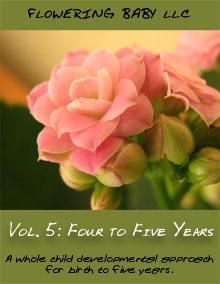 Flowering Baby, LLC
Flowering Baby, LLC is a "Whole child developmental approach." for children from birth to five. It has sections for each of these year groups. Flowering Baby is based on activities that the author, Martha Saunders, did with her son, using input from her mother and second author, Carolyn Schulte, an early education expert.
We have been using the
four to five programme.

and I've had a look through the
three to four year programme as I wasn't sure which would be best for Youngest Son who has just turned four. These products are available as CDs.

Both the three to four year old and the four to five year old programmes have two sections. There is a section to be used each month and another with twenty four themes. The suggestion is that two of these themes are used each month. So far, we have used the Aquarium and Arctic life theme and most appropriately, the one on winter. The month curriculum guide covers about 12 days of the month whereas the themes last three to eight days.
The CDs for the age groups younger than three are not divided up in this way but, instead, are divided into age months with activities for twenty days in the month. These include singing, stories, early maths concepts, games and craft.
The programme is intended to take 20-40 minutes a day. Using the four to five year old programme takes closer to 40 than 20 minutes.
Each day, the month guide gives activities which usually include reading to the child, listening to the alphabet song and practising writing an individual letter and exposing the child to another language. Flowering Baby suggests using Spanish but also state that another language can be used. We chose to use French. Most days there is a maths section which might be simple counting using toys or other objects or something around shapes. Other activities include learning about a healthy diet, following instruction games and learning one's phone number.
What we thought about Flowering Baby:
The read alouds went well especially as the author allows leeway for changing to other more readily available books on the same theme. There were several suggestions for arctic/aquarium books. We managed to find several of these, and more.
Youngest Son liked the maths activities. Taping a shape on the floor and walking round it was a real success.
The music section made me think about having music playing more and it was helpful to have a prompt to start another language at this age.
However, the writing section was difficult. Youngest Son is only just four and whilst he enjoys learning about letters and finding objects beginning with a letter, writing is something else. We worked instead on fine motor control in different media. Looking back some of the year 3 activities might have been more suitable as these focus on holding a crayon or pencil, mark making, drawing simple shapes and the child's name. Year 4 includes writing mainly with a different letter to practise each day.
Flowering Baby is produced in the US and this is reflected in some of the days which are celebrated. President's Day and Groundhog Day don't feature large in the UK!
The themes were appreciated especially as we had snow just as we started the topic of winter. Taking a snow walk, as suggested, became easy!
Flowering Baby is available from the Flowering Baby, LLC store. Samples of the 4-5 curriculum can be seen at the bottom of
this page and the 3-4 on
this page. The 3-4 and 4-5 curricula both cost $38 for CDs. However, for a 10% discount, use the code Blog10 when ordering.
To read more reviews of Flowering Baby go to
The Old Schoolhouse Crew blog.

Disclaimer: I received a free copy of this product through the Schoolhouse Review Crew in exchange for my honest review. I was not required to write a positive review nor was I compensated in any other way. All opinions I have expressed are my own or those of my family. I am disclosing this in accordance with the FTC Regulations.



 Flowering Baby, LLC is a "Whole child developmental approach." for children from birth to five. It has sections for each of these year groups. Flowering Baby is based on activities that the author, Martha Saunders, did with her son, using input from her mother and second author, Carolyn Schulte, an early education expert.
Flowering Baby, LLC is a "Whole child developmental approach." for children from birth to five. It has sections for each of these year groups. Flowering Baby is based on activities that the author, Martha Saunders, did with her son, using input from her mother and second author, Carolyn Schulte, an early education expert. and I've had a look through the three to four year programme as I wasn't sure which would be best for Youngest Son who has just turned four. These products are available as CDs.
and I've had a look through the three to four year programme as I wasn't sure which would be best for Youngest Son who has just turned four. These products are available as CDs.

